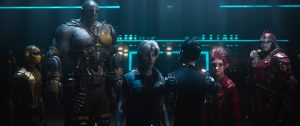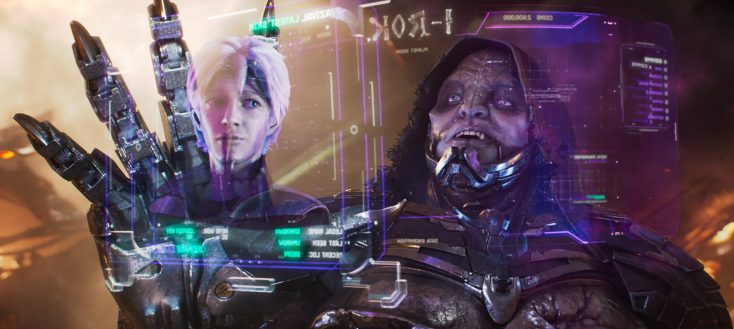
(L-r) Sho voiced by Philip Zhao, Aech voiced by Lena Waithe, Parzival voiced by Tye Sheridan, the Curator, Art3mis voiced by Olivia Cooke and Daito voiced by Win Morisaki in READY PLAYER ONE. ©Warner Bros. Entertainment. CR: Jaap Buitendijk.
By HEATHER TURK
Front Row Features Film Critic
It seems only appropriate that Steven Spielberg’s latest film, which focuses on Easter eggs of the video game kind, is being released over the Easter holiday weekend. While video game enthusiasts will no doubt enjoy the visual wonder that is “Ready Player One,” fans of the book the movie is based on will be left severely underwhelmed.
Based loosely on Ernest Cline’s 2011 sci-fi novel of the same name, “Ready Player One” takes place in 2045, where much of humanity uses the virtual reality software OASIS to escape the desolation of the real world. There, players have the freedom to become anyone they want and do anything they want—even if all they want to do is climb Mount Everest with Batman. For 18-year-old orphan Wade Watts (Tye Sheridan, “X-Men: Apocalypse”), the OASIS is where he goes to hang out with his best friend Aech (Emmy winner Lena Waithe, “Master of None”), who he’s never actually met in real life.
When James Halliday (Academy Award winner Mark Rylance, “Bridge of Spies”), the eccentric co-creator of the OASIS, dies, he leaves his fortune and the future of his virtual reality world to whomever can beat a game he hid within it called Anorak’s Quest. The first to find three hidden keys through a series of puzzles will unlock an Easter egg granting them full ownership of the OASIS—something that appeals to Nolan Sorrento (Ben Mendelsohn, “Rogue One: A Star Wars Story”), CEO of the tech conglomerate Innovative Online Industries (IOI). He wants to take control of the popular freeware so that he can restrict access to it and start charging users a premium, meaning only the uber wealthy may soon be able to escape to the OASIS.
After Wade beats Halliday’s first quest and receives the first hidden key, he finds IOI hot on his trail trying to stop him from winning control of the OASIS. Despite first setting out to beat Anorak’s Quest on his own, Wade soon finds himself teaming up with Aech and three other friends he’s met within the virtual reality world—Art3mis (Olivia Cooke, “Bates Motel”), Sho (newcomer Philip Zhao) and Daito (Win Morisaki of the Japanese pop band PrizmaX)—to find the remaining keys and save the OASIS from IOI’s planned takeover.
While the basic story outline is the same, those who read Cline’s best-selling novel will notice several major differences between his futuristic story and the screenplay he helped pen with Zak Penn (“Behind Enemy Lines”). The big-screen adaptation isn’t quite as dark, although IOI does still try to kill Wade in the real world, and the many ’80s pop culture references for which the novel is known are cut down drastically. In fact, most of the pop culture references kept in the movie have already been seen in the film’s trailers, and minus an extended sequence dedicated to “The Shining,” most of them appear on-screen so briefly that if you blink, you might miss them altogether. Additionally, whereas in the book many of the references actually serve a purpose to further the story, here the only purpose most of them have is to make viewers go, “Oh look, it’s Freddy Krueger!”
All of the actors do a decent enough job with the material they are given, although none of them deliver truly memorable performances. The closest thing viewers get to scene-stealing performances are Cooke as Wade’s love interest, Art3mis, and T.J. Miller (“Silicon Valley”) as the film’s main comic relief character, I-R0k, a bounty hunter with a bad neck employed by IOI to help them win the game.
Of course, no one is going to see “Ready Player One” for Oscar-worthy performances—they’re coming to see Oscar-worthy visuals, and for the most part, the film doesn’t disappoint in that department. The OASIS is truly stunning, and although this particular press screening wasn’t shown in 3-D, one can’t help but feel while watching the film that this is the type of movie 3-D was created for. What’s surprising, though, is just how grainy the scenes in the real world look on the big screen. While one could argue the graininess was an artistic choice, the scenes look more like notorious filmmaker Tommy Wiseau (“The Room”) directed them than Academy Award winner Steven Spielberg, they come across so amateurish.
Clocking in at nearly two-and-a-half hours, “Ready Player One” also starts to stall out by its final act. The excitement of the competition is long gone by the time the movie gets to the real high-stakes chase between Wade and Nolan. It’s almost like a video game you’ve played for far too long in hopes of beating it—viewers will care more about the film finally ending than how the story actually wraps up.
Ultimately, “Ready Player One” is a lot of flash and not a lot of substance. It manages to keep the average viewer’s interest for the most part, but it’s nowhere near Spielberg’s best and doesn’t do justice to Cline’s source material. Even though it’s a film clearly meant to be seen on the big screen, unless you’re a huge video game fan, “Ready Player One” can easily be skipped in theaters. Audiences won’t be missing much.
Grade: C+





